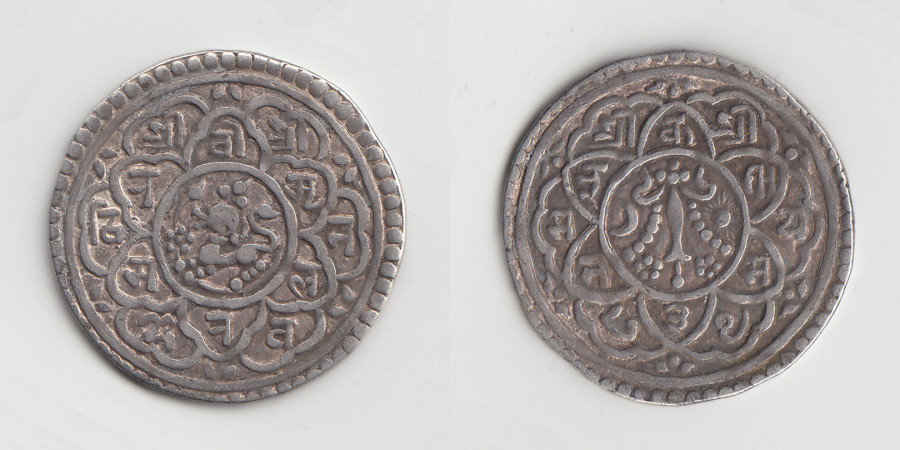Columns
Nepal Sambat on Nepali coins
Silver 'mohars' bearing the home-grown era once circulated on either side of the Himalaya.
Kamal Ratna Tuladhar
As a merchant in Lhasa in the 1940s, one of my father's main businesses was exporting old Nepali coins to India. Tonnes of them. These silver mohars were no longer used as money in Tibet and were traded for their bullion value. The coins were transported from Lhasa to Kalimpong by mule caravan and from there to Kolkata by motor and rail. In Kolkata, the coins were melted down and cast into bars and then shipped back to Tibet. Long lines of pack mules snaked over the Himalayan passes going back and forth between Kalimpong and Lhasa—carrying coins one way and silver bars the other way. Many Nepali merchants like my father talk about sending whole caravans laden with silver mohars to Kalimpong.
Each mule would carry two sacks of coins, one on each side. Each sack contained about 5,000 pieces. Many traders were engaged in the business, and the transactions continued for many years. So they must have sent millions of pieces to be turned into bullion. For the Nepali merchants in Lhasa, Kolkata was the start and the end of the trade route to Tibet. Kolkata was where they sourced their Tibet-bound merchandise, and it was also where they found buyers for their Tibetan goods coming in exchange. The market for the unused mohars also lay in Kolkata, and so that's where they were dispatched.
Numismatists will wince at the thought of the old silver mohars being sent to be melted down. All those pieces with exotic designs from centuries past. And how did so many Nepali coins end up in Tibet? It so happened that once upon a time, they were used as money there. Tibetan currency hadn't been created then, and Nepali coins were the obvious choice to fill the lack. From the 17th to the 18th centuries, all three Malla kings in Kathmandu Valley struck coins on behalf of Tibet with their own names and emblems on them. They were legal tender, and Tibet's mile-high bazaars reverberated with the jingle jangle of Nepali silver mohars. After Tibet began minting its own currency, the demonetised coins were good for their silver content, and so they ended up in the foundry.
The mohars that survived into the modern age bring smiles to the faces of collectors and are keenly sought-after items in the numismatic world. Scholars study the designs and write lengthy treatises about the motifs and meanings. Collectors cherish them and proudly display their possessions at exhibitions. Like most things in Nepal, the coinage was instilled with religious symbolism. The mohars are inscribed with the name of the king on the front and a sacred salutation, and the year on the back. The letters are in Nepal script, and the year is Nepal Sambat. The sacred salutations are addressed to Hindu and Buddhist deities like Taleju and Karunamaya and are inscribed on a mandala design. The common emblems found on these coins are thunderbolt, trident, sword, sun and moon. There are also coins showing the eight auspicious symbols of Buddhism—fish, umbrella, conch, endless knot, victory banner, vase, lotus and wheel of law.
The lunar Nepal Sambat was the commonly used calendar era in those days. It featured on coinage, legal documents and stone and copper inscriptions from very early times. This calendar era prevailed till the late 18th century, after which it went out of official favour and was pushed into the background. But Nepal Sambat continued to be remembered in cultural life and religious celebrations. About a century ago, a journalist and scholar from Patan named Jagat Man Vaidya worked to get the calendar era accepted in official use. He is better known by his pen name Dharmaditya Dharmacharya. In later times, the movement for Nepal Sambat took the form of poetry recitals, drama festivals, welcome arches, and bicycle and motorcycle rallies and cultural processions on new year's day. Every year, the slogan was the same: Nepal Sambat should be recognised as the national era.
In 2008, during the new year programme at Kathmandu Durbar Square, people saw the culmination of the years of effort. It was a beautiful sunny morning. The then prime minister Pushpa Kamal Dahal stood up on the dais to address the crowds and declared Nepal Sambat as the national era. It had finally regained official recognition. That was a historic proclamation, but that's where things have remained since then—a historic declaration without any follow-up. It would be good to give the national era the appropriate honours, and the suitable thing to do would be to show it on the national currency like before. The first day of Nepal Sambat 1142 comes around on November 5. That may be an excellent occasion to decide to put it on Nepali coinage and banknotes. Seeing the home-grown era back on Nepali currency will make the country proud, and also remind us of the days when silver mohars bearing Nepal Sambat circulated on either side of the Himalaya.




 12.12°C Kathmandu
12.12°C Kathmandu















